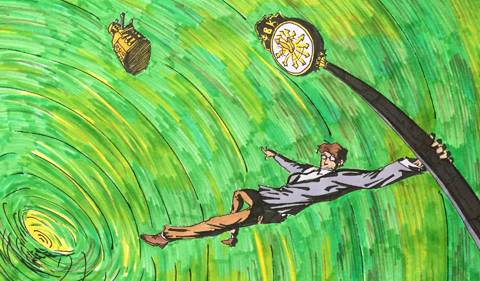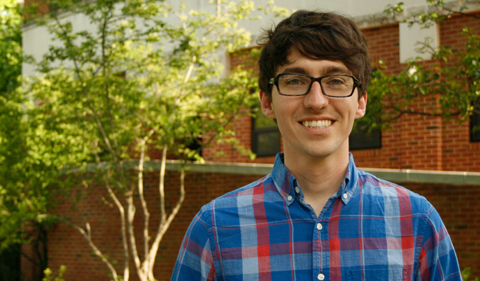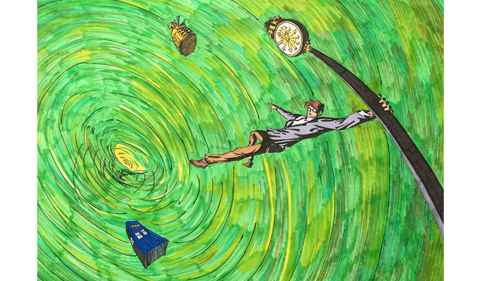
Artist’s concept of Doctor Who at Baker University Center Illustration: Peter Zeisler, ’15 BFA
Fans of the British science-fiction television program “Doctor Who” may wonder how time travel could possibly work.
Dr. Zach Meisel, Assistant Professor of Physics & Astronomy, provides a physicist’s perspective on what would be necessary if the stuff of science fiction were possible. What conditions would be necessary to travel through space and time?
First aired in 1963, the BBC-produced television series depicts the adventures of the Doctor, a fictional Time Lord, a humanoid-alien who journeys through time and space of the universe. He travels in his TARDIS, a sentient space ship whose exterior looks like a British police box of the 1960s. Along the way, he is accompanied by companions who help him to combat evil foes, while working to save those in need. Twelve actors have headlined the series as the Doctor, to depict the life process of a Time Lord, who takes on a new body and personality after sustaining an injury which would be fatal to other species.
Since 2005 when the popular show was relaunched, series producers have aired a special episode on Dec. 25. This year’s show marks the beginning of Season 10.
A Time Lord’s Guide to Time Travel
By Zach Meisel
Physics & Astronomy
There you are, staring down the barrel of a Dalek death-ray, awaiting certain doom. Suddenly, after a quick diversion and a clever quip, you’re on your TARDIS and out of danger. After all, you’re the Doctor. But how exactly did you manage to get here, hurtling through space and time in a retro phone booth? Let me explain (from a human perspective, of course).
Time travel is the premise that time is not an irreversible sequence of unfolding events, but rather a medium in which one can discretely move from one occurrence to another, without the restriction that one action logically progresses to the next. In a universe with time travel, “before” and “after” are only relative descriptors of the time dimension, as “left” and “right” are for the three spatial dimensions. From the perspective of a Time Lord, space and time are best thought of as a “big ball of wibbly-wobbly, timey-wimey stuff.”

Dr. Zach Meisel
Presently, time travel lacks any rigorous description and is based on philosophy as much as physics. However, a handful of concepts for time travel have been proposed, each as unique (and possibly problematic) as your many incarnations as the Doctor. According to special relativity, movement faster than the speed-of-light would enable motion backwards in time, though at the cost of an infinite amount of energy. For those with a more modest budget, one can turn to the wormholes of general relativity. A wormhole is a hypothetical bridge in spacetime connecting two places separated in space and/or time. These objects have a rather rigorous mathematical foundation, but require the existence of “negative energy”. Negative energy implies the existence of a force following a sort of anti-Newton’s-3rd-Law: For every action there is an equal and not opposite reaction. This is interesting, but lacking a sound observational basis.
From a conceptual perspective, each time travel theory that allows movement backwards in time confronts the logical barrier of causality. Causality requires that the beginning of an event comes before its end. For example, I need to have written these words before you have read them. Violation of this axiom calls into question the existence of free will and introduces a host of paradoxes. Must things unfold as they did if you went back and experienced an event again? Chaos theory suggests not. If someone can travel back in time, what stops them from preventing their parents from ever meeting? Perhaps such wrinkles in time are prevented by the faithful stewardship of the Time Lords.
Time travel into the future is more palatable in terms of both physics and philosophy. In fact, you’re traveling forward through time right now. For those wishing to travel into the future further than a human lifespan, relativity offers a handy option. Time dilation, the change in the rate at which time elapses, induced by high-speed travel or proximity to a strong gravitational field are both established phenomena. Indeed, muons produced by cosmic rays in our atmosphere move through time roughly ten times as fast relative to a stationary observer due to their ~99% light-speed motion. Further enhancements could be realized by achieving higher speeds. However, approaching light-speed requires approaching infinite momentum. Philosophically speaking, the contents of our bookshelves and music libraries are evidence of another sort of time travel into the future, where words and notes generated long ago impact the present day. Of course such a technicality is of little use to a Time Lord needing to evade impending oblivion.
This rather pessimistic outlook on time travel may lead you to wonder how your TARDIS is tumbling through the spacetime continuum and where it could be tumbling to. Fear not. Human-initiated scientific investigations yield exciting results every day and something like an enhanced-relativity theory could be just around the corner. As you might say, Fantastic!

Full illustration by Peter Zeisler



















Comments